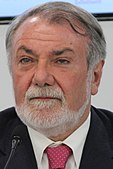2004 European Parliament election in Spain
| |||||||||||||||||||||||||||||||||||||||||||||||||||||||||||||||||||||||||||||||||||||||||||||||||||||
All 54[a] Spanish seats in the European Parliament | |||||||||||||||||||||||||||||||||||||||||||||||||||||||||||||||||||||||||||||||||||||||||||||||||||||
|---|---|---|---|---|---|---|---|---|---|---|---|---|---|---|---|---|---|---|---|---|---|---|---|---|---|---|---|---|---|---|---|---|---|---|---|---|---|---|---|---|---|---|---|---|---|---|---|---|---|---|---|---|---|---|---|---|---|---|---|---|---|---|---|---|---|---|---|---|---|---|---|---|---|---|---|---|---|---|---|---|---|---|---|---|---|---|---|---|---|---|---|---|---|---|---|---|---|---|---|---|---|
| Registered | 34,706,044 | ||||||||||||||||||||||||||||||||||||||||||||||||||||||||||||||||||||||||||||||||||||||||||||||||||||
| Turnout | 15,666,491 (45.1%) | ||||||||||||||||||||||||||||||||||||||||||||||||||||||||||||||||||||||||||||||||||||||||||||||||||||
| |||||||||||||||||||||||||||||||||||||||||||||||||||||||||||||||||||||||||||||||||||||||||||||||||||||
 Provincial results map for the European Parliament in Spain | |||||||||||||||||||||||||||||||||||||||||||||||||||||||||||||||||||||||||||||||||||||||||||||||||||||
The 2004 European Parliament election in Spain was held on Sunday, 13 June 2004, as part of the European-wide election to elect the 6th European Parliament. All 54 seats allocated to Spain as per the Treaty of Nice were up for election.[a]
Electoral system
The 54 members of the European Parliament allocated to Spain as per the Treaty of Nice[a] were elected using the D'Hondt method and a closed list proportional representation, with no threshold being applied to be entitled to enter seat distribution. However, the use of the D'Hondt method might result in an effective threshold depending on the district magnitude.[1] Seats were allocated to a single multi-member constituency comprising the entire national territory. Voting was on the basis of universal suffrage, which comprised all nationals and resident non-national European citizens over eighteen and in full enjoyment of their political rights.[2][3][4]
The electoral law provided that parties, federations, coalitions and groupings of electors were allowed to present lists of candidates. However, they were required to secure the signature of at least 15,000 registered electors. Electors were barred from signing for more than one list of candidates. Parties, federations and coalitions were allowed to replace this requirement with the signature of at least 50 elected officials—deputies, senators, MEPs or members from the legislative assemblies of autonomous communities or from local city councils—. Concurrently, parties and federations intending to enter in coalition to take part jointly at an election were required to inform the relevant Electoral Commission within ten days from the election call.[2][3]
Parties and leaders
| Parties and coalitions | Composition | Ideology | Candidate | |
|---|---|---|---|---|
| width="1" bgcolor="Template:Spanish Socialist Workers' Party/meta/color"| | Spanish Socialist Workers' Party (PSOE) | Social democracy | Josep Borrell[5] | |
| bgcolor="Template:People's Party (Spain)/meta/color"| | People's Party (PP) | Liberal conservatism | Jaime Mayor Oreja[6] | |
| bgcolor="Template:Galeusca–Peoples of Europe/meta/color"| | Galeusca–Peoples of Europe (Galeusca) | Peripheral nationalism | Ignasi Guardans[7][8] | |
| bgcolor="Template:United Left (Spain)/meta/color"| | United Left–ICV–EUiA (IU–ICV–EUiA) | Democratic socialism | Willy Meyer[9][10] | |
| bgcolor="Template:Europe of the Peoples/meta/color"| | Europe of the Peoples (EdP) | Peripheral nationalism | Bernat Joan | |
| bgcolor="Template:European Coalition (2004)/meta/color"| | European Coalition (CE) | Regionalism | Alejandro Rojas-Marcos | |
Results
Overall
| Parties and coalitions | Popular vote | Seats | ||||
|---|---|---|---|---|---|---|
| Votes | % | ±pp | Total | +/− | ||
| width="1" bgcolor="Template:Spanish Socialist Workers' Party/meta/color"| | Spanish Socialist Workers' Party (PSOE) | 6,741,112 | 43.46 | +8.13 | 25 | +1 |
| bgcolor="Template:People's Party (Spain)/meta/color"| | People's Party (PP) | 6,393,192 | 41.21 | +1.47 | 24 | –3 |
| bgcolor="Template:Galeusca–Peoples of Europe/meta/color"| | Galeusca–Peoples of Europe (Galeusca)1 | 798,816 | 5.15 | –2.87 | 2 | –2 |
| bgcolor="Template:United Left (Spain)/meta/color"| | United Left–ICV–EUiA (IU–ICV–EUiA)2 | 643,136 | 4.15 | –2.36 | 2 | –2 |
| bgcolor="Template:Europe of the Peoples (2004)/meta/color"| | Europe of the Peoples (EdP)3 | 380,709 | 2.45 | +1.34 | 1 | –1 |
| bgcolor="Template:European Coalition (2004)/meta/color"| | European Coalition (CE)4 | 197,231 | 1.27 | –2.17 | 0 | –2 |
| Blank ballots | 95,014 | 0.61 | –1.08 | |||||
| Total | 15,512,282 | 54 | –10 | |||||
| Valid votes | 15,512,282 | 99.02 | –0.19 | |||||
| Invalid votes | 154,209 | 0.98 | +0.19 | |||||
| Votes cast / turnout | 15,666,491 | 45.14 | –17.91 | |||||
| Abstentions | 19,039,553 | 54.86 | +17.91 | |||||
| Registered voters | 34,706,044 | |||||||
| Sources[11][12] | ||||||||
| ||||||||
Distribution by European group
| Groups | Parties | Seats | Total | % | |
|---|---|---|---|---|---|
| width="1" bgcolor="Template:Party of European Socialists/meta/color"| | Party of European Socialists (PES) |
|
24 | 24 | 44.44 |
| bgcolor="Template:European People's Party/meta/color"| | European People's Party–European Democrats (EPP–ED) |
|
24 | 24 | 44.44 |
| bgcolor="Template:The Greens–European Free Alliance/meta/color"| | The Greens–European Free Alliance (Greens–EFA) |
|
1 1 1 |
3 | 5.56 |
| bgcolor="Template:European Liberal Democrat and Reform Party/meta/color"| | European Liberal Democrat and Reform Party (ELDR) |
|
1 1 |
2 | 3.70 |
| bgcolor="Template:European United Left–Nordic Green Left/meta/color"| | European United Left–Nordic Green Left (GUE/NGL) |
|
1 | 1 | 1.85 |
| Total | 54 | 54 | 100.00 | ||
Notes
- ^ a b c Note that while the Treaty of Nice initially allocated 50 seats to Spain, it provided for a total European Parliament size of 732 which—as a result of Bulgaria and Romania not acceessing the European Union until 2007—allowed for Spain to be awarded four additional seats, which it maintained for the entire 2004–2009 term.
References
- ^ Gallagher, Michael (30 July 2012). "Effective threshold in electoral systems". Trinity College, Dublin. Retrieved 22 July 2017.
- ^ a b "General Electoral System Organic Law of 1985". Organic Law No. 5 of 19 June 1985 (in Spanish). Retrieved 6 March 2017.
{{cite book}}:|work=ignored (help) - ^ a b "Representation of the people Institutional Act". juntaelectoralcentral.es. Central Electoral Commission. Retrieved 16 June 2017.
- ^ "Treaty of Nice amending the Treaty on European Union, the Treaties establishing the European Communities and certain related acts". Act of 10 March 2001. Retrieved 21 July 2017.
{{cite book}}:|work=ignored (help) - ^ "Borrell y Díez encabezarán la lista del PSOE para las elecciones europeas". El País (in Spanish). Madrid. 21 April 2004. Retrieved 21 July 2017.
- ^ Marcos, Pilar (23 April 2004). "El PP designa a Mayor para que encabece su lista en las elecciones al Parlamento Europeo". El País (in Spanish). Madrid. Retrieved 21 July 2017.
- ^ Garriga, Josep (15 January 2004). "Ignasi Guardans sustituirá a Gasòliba como 'número uno' de CiU en las europeas". El País (in Spanish). Barcelona. Retrieved 21 July 2017.
- ^ Aymi, Oriol (25 April 2004). "CiU y ERC aprueban sus listas para las próximas elecciones europeas". El País (in Spanish). Tarragona. Retrieved 21 July 2017.
- ^ Elordi Cué, Carlos (22 April 2004). "La dirección de IU sanciona la lista europea con el apoyo del 68%". El País (in Spanish). Madrid. Retrieved 21 July 2017.
- ^ Agencias (8 May 2004). "Willy Meyer será el candidato de IU a las elecciones europeas". Cadena SER (in Spanish). Madrid. Retrieved 21 July 2017.
- ^ "Electoral Results Consultation. European Parliament. June 2004. National totals". infoelectoral.mir.es (in Spanish). Ministry of the Interior. Retrieved 24 September 2017.
- ^ "European election 13 June 2004". historiaelectoral.com (in Spanish). Electoral History. Retrieved 24 September 2017.
- ^ "Parlamento Europeo: Distribución de los Eurodiputados españoles en grupos parlamentarios". historiaelectoral.com (in Spanish). Retrieved 17 March 2017.
External links
- European elections Spain in Europe Politique.




